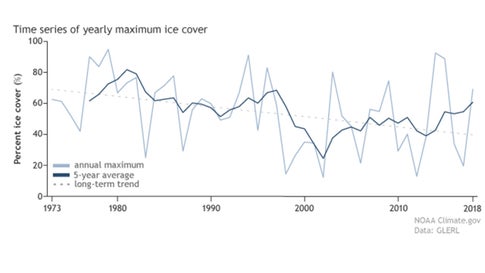Great Lakes Ice Cover Has Been Decreasing Since the 1970s, Study Says
Apr 24, 2019 05:51PM ● By Editor
By Pam Wright of The Weather Channel - April 24, 2019
Ice cover on the Great Lakes and Lake St. Clair has been decreasing since the 1970s, impacting everything from fishing to shipping, a new study says.
The ice cover on the Great Lakes begins each year along shallower coasts during late fall and early winter and typically peaks in late winter and early spring. Most lakes remain partially ice free even during the time of maximum ice cover.
Lake Michigan and Lake Ontario, for example, tend to remain 80 to 90 percent ice free, largely because they are so deep. Lake Erie, on the other hand, is shallower and is typically 70 percent ice-covered by late winter, according to a press release.
The amount of ice cover fluctuates year to year, but the overall trend is downward over the past four decades. The trend for peak ice cover on all of the lakes has gone from about 70 percent in 1973 to roughly 40 percent by 2018, according to data by the Great Lakes Environmental Research Laboratory (GLERL).

The fluctuation is partially a result of several larger climate patterns like the El Niño Southern Oscillation (ENSO), North Atlantic Oscillation (NAO), Atlantic Multi-decadal Oscillation (AMO) and the Pacific Decadal Oscillation (PDO).
Not all of the lakes have seen the same decrease in ice cover. Lakes Superior, Huron and Erie have seen the greatest declines, due to a "combination of natural climate influences as well as influences from man-made climate change," the press release points out.
According to a separate study by NOAA-funded GLISA, a partnership between the University of Michigan and Michigan State University, ice coverage declined by 71 percenton all five Great Lakes and Lake St. Clair between 1973 and 2010.
That includes a 37 percent decline on Lake St. Clair, a 50 percent decline on Lake Erie and an 88 percent decline on Lake Ontario.
The study noted that waters have warmed significantly from 1973 to 2010. Lake Superior saw summer water surface temperatures increase 4.5 degrees Fahrenheit. The increase is credited, in part, to less ice cover, which allows a "longer period to warm and amplify the effects of warmer summer air temperatures."
The downward trend could spell trouble for the ecosystem and the people who rely on the lakes, including those in the fishing and shipping industry.
While less ice could benefit the multi-billion dollar shipping industry, since freighters often get stuck in ice each year at a significant cost to companies, it could negatively impact the local climate and ecosystems.
Less ice on the lakes results in more moisture in the atmosphere, which could lead to greater lake-effect precipitation downwind, meaning more lake-effect snow for places like Buffalo.
It also means greater water evaporation, which, in turn, lowers lake water levels, particularly during the summer months.
In terms of ecosystems, certain species like Whitefish rely on ice cover. Whitefish use the ice cover to protect their eggs during massive winter storms. Should waters continue to warm, cold-water fish like Whitefish would have to compete with warm-water fish for food and other resources, the press release notes.
To see the original article and read related climate and weather reporting, follow this link to the Weather Chanel website. https://weather.com/science/environment/news/2019-04-24-great-lakes-ice-coverage-declining

